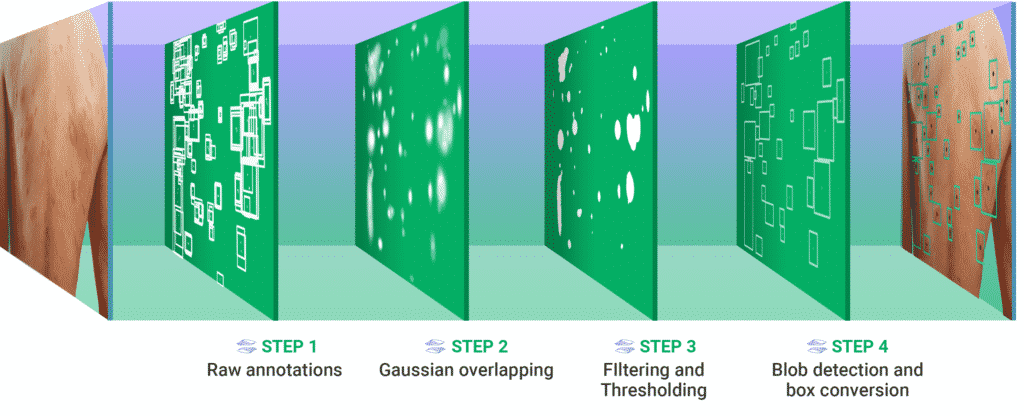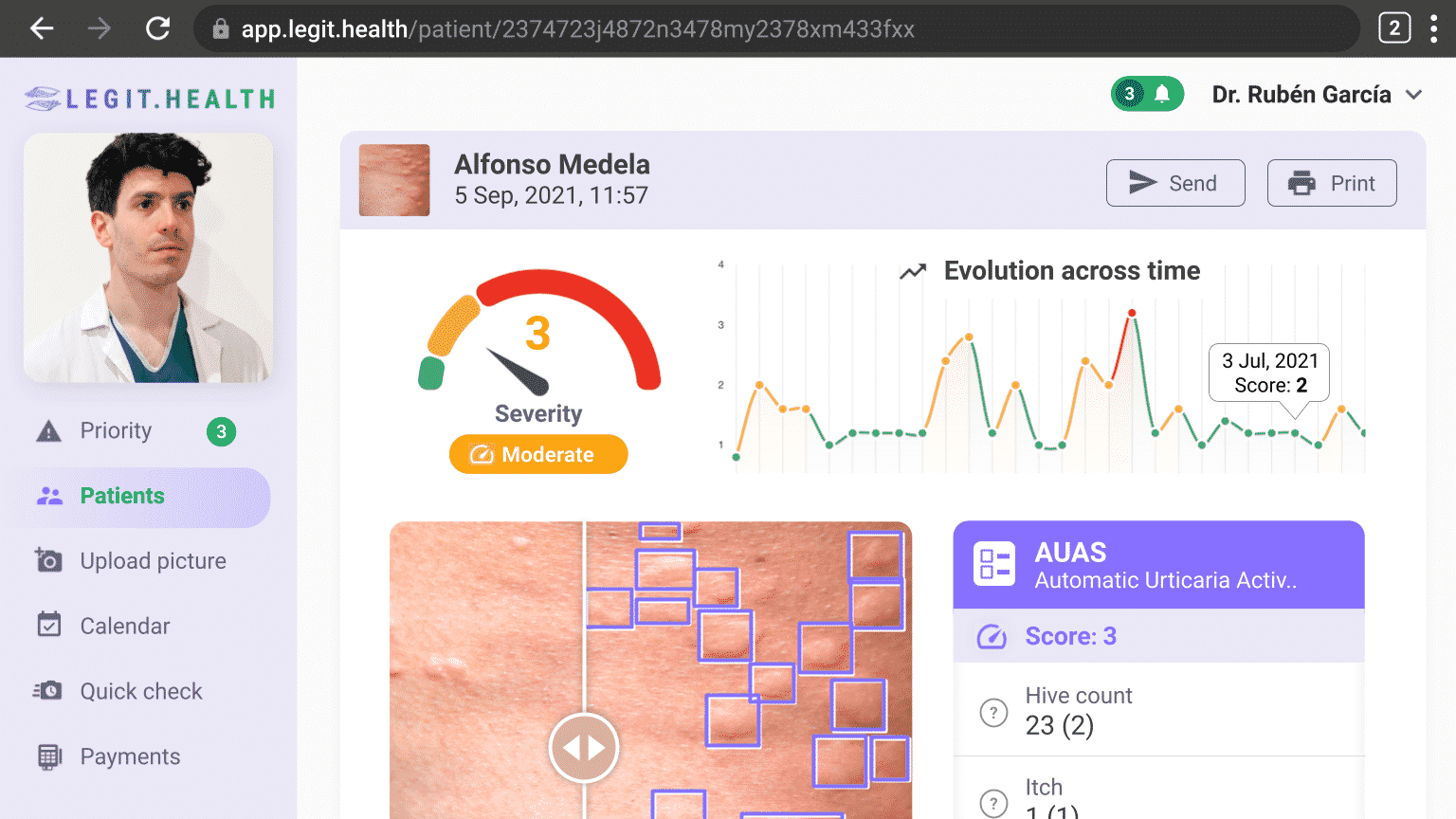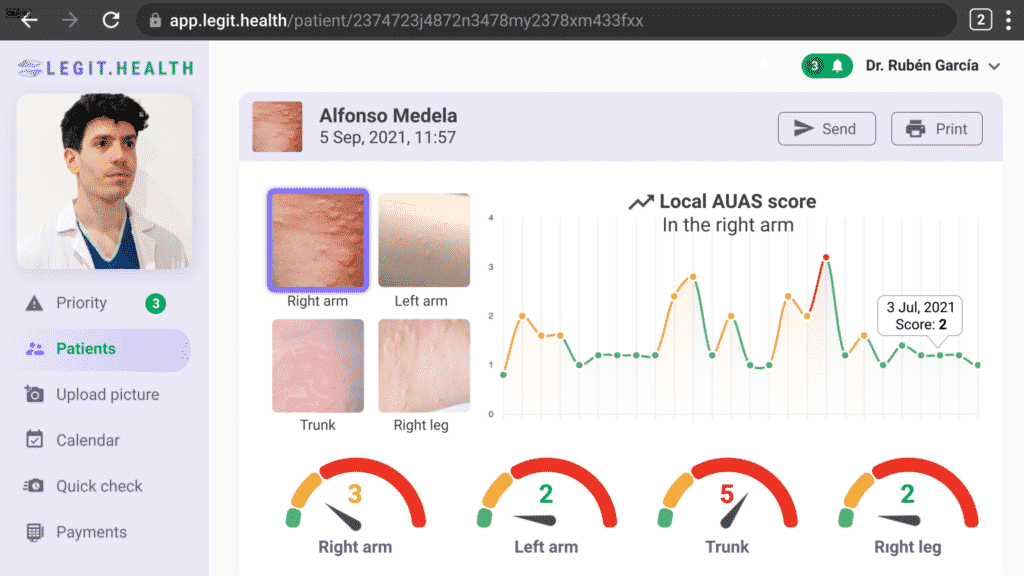Automatic Urticaria Activity Score (AUAS): A Novel Technology for Urticaria Severity Assessment Based on Automatic High-Precision Hive Counting
This post is a summary of a scientific publication published in the Journal of Investigative Dermatology (JID) Innovations. We encourage you to read the whole publication, which is embedded below.
Read the paper
We invite you to read the full paper for yourself, or you can scroll down to read the summary in this educational blog post.
Introduction
We introduce AUAS, an automatic equivalent of UAS that deploys a deep learning lesion-detecting algorithm, called Legit.Health-UAS-HiveNet. Our results show that our algorithm assesses the severity of Chronic Urticaria cases with a performance comparable to that of expert physicians.
Furthermore, the algorithm can be implemented into CADx systems to support doctors in their clinical practice and act as a new endpoint in clinical trials.
The real impact of the Legit.Health-UAS-HiveNet in clinical practice resides on the power to support physicians during not only the diagnostic process but also in the monitoring of patients with chronic types of urticaria, by helping them prescribe treatments and increase the adequacy of treatments.
Regarding clinical trials, the AUAS has the potential of becoming a new clinical endpoint that could increase both the quality and the quantity of data available to researchers.
Authors of the publication

Rubén Garcia
Hospital Universitario Fundación Jiménez Díaz

Alejandro Vilas
Complejo Hospitalario U. de Ferrol

Laura Vergara
Hospital Universitario de Toledo

Taig Mac Carthy
Department of Clinical Endpoint Innovation Legit.Health

Fernando Alfageme
Hospital Puerta de Hierro

Ana María González
Hospital de Zamora

Ignacio Hernandez
Medical Data Science Legit.Health

Alfonso Medela
Medical Data Science Legit.Health
What is urticaria severity scoring?
Urticaria is a very common disease characterized by erythematous, edematous, itchy, and transient plaques that involve the skin and mucous membranes. It can be classified into subtypes such as acute spontaneous urticaria, chronic spontaneous urticaria, chronic inducible urticaria, and episodic chronic urticaria.
Diagnosis of chronic urticaria is usually performed through clinical observation. In other words: the assessment of the disease's severity is performed through manual scoring systems that are filled in subjectively.
The most commonly used scoring system is the Urticaria Activity Score (UAS), which can also be used for 7 consecutive days, in which case it is referred to as UAS7.
The problem with visual scoring
The most indisputable limitation of manual scoring systems is the inherent difficulty of human beings to quantify parameters in an objective, stable and precise way.
Humans have a limited ability to count hives, quantify the surface area of a lesion or quantify the redness of an area. This human limitation in parameter estimation is also reflected in the effort and time required to complete the urticaria activity questionnaires, which end up being a very unrewarding task for patients and may result in poor adherence.
On the other hand, scoring systems classify disease severity using a limited range of scores, with three or four categories, such as: none, mild, moderate and severe in the case of the UAS. Indeed, questionnaires have a very high minimum detectable change, as they are discrete ranges rather than continuous scales.
And finally, these questionnaires are susceptible to bias. This is especially true in cases where the patient knows that the treatment they receive will be determined by the information they provide. And due to the asynchronous nature of the reported measure, the clinical team lacks the means to ensure that the values reported by the patient are chronologically accurate or simply truthful, which precludes external verification.
The goal of the Automatic UAS
In this work, we propose the Automatic Urticaria Activity Score (AUAS), an automatic version of the objective part of the UAS that applies convolutional neural networks to count hives automatically with high precision.
The goal is to assist clinicians in filling scoring systems such as the UAS in a more objective way and quicker, which could improve health outcomes and provide high-quality endpoints to measure the effectiveness of the treatments for urticaria.

Explanation of how the artificial intelligence identifies hives in urticaria images.
The solution
We trained trained a hive-counting neural network called Legit.Health-UAS-HiveNet.
To make artificial intelligence accessible to the healthcare professional, we developed a fully integrated CADx system, a web application that integrates Legit.Health-UAS-HiveNet algorithm and calculates the patient-based UAS by looking at images taken with smartphone cameras.
The CADx system works in three stages: image and itchiness input, processing of the images, and the creation of a report with the severity assessment.

Caption of a full report from the CADx system. The chart at the top right shows the evolution of the urticaria, by plotting the AUAS scores across time.
The report can also combine the scores of multiple images uploaded in the same day to provide the global AUAS score.
In other words: if the user uploads pictures of several body parts, the report of the CADx system shows both the local and the global AUAS scores. The global AUAS is calculated by summing the results of all the images processed by the CADx system.

¿Quiere ver la tecnología de IA dermatológica en acción?
Conclusion
In this work, we have presented the AUAS, the first artificial intelligence that automatically fills in the UAS scoring system by looking at smartphone images. The main advances in this algorithm are reducing the time spent by patients in filling in the manual severity scoring system and standardizing urticaria assessment with reduced inter-observer variability and higher reliability.
We were able to overcome clinical assessment variability by developing a merging algorithm that fuses all experts' annotations to create a consensus.
The AUAS as a scoring system presents improved clinimetric properties, but it also carries the advantage of providing a picture of the lesion along with the severity score, which allows researchers greater oversight of studies. In conclusion, we believe that the AUAS and Legit.Health-UAS-HiveNet has the potential to improve health outcomes, reduce costs, and increase the practice of evidence-based medicine in health organizations.
Get access now
Empieza ahora
Dermatología con IA validada por investigación revisada por pares. De confianza en los principales hospitales de Europa. Rellena el formulario para ver cómo nuestra plataforma con marcado CE puede transformar tu práctica.



